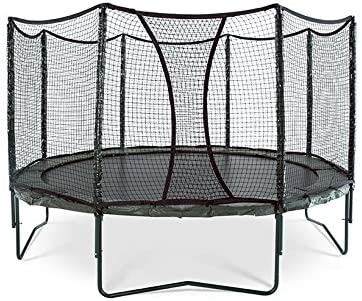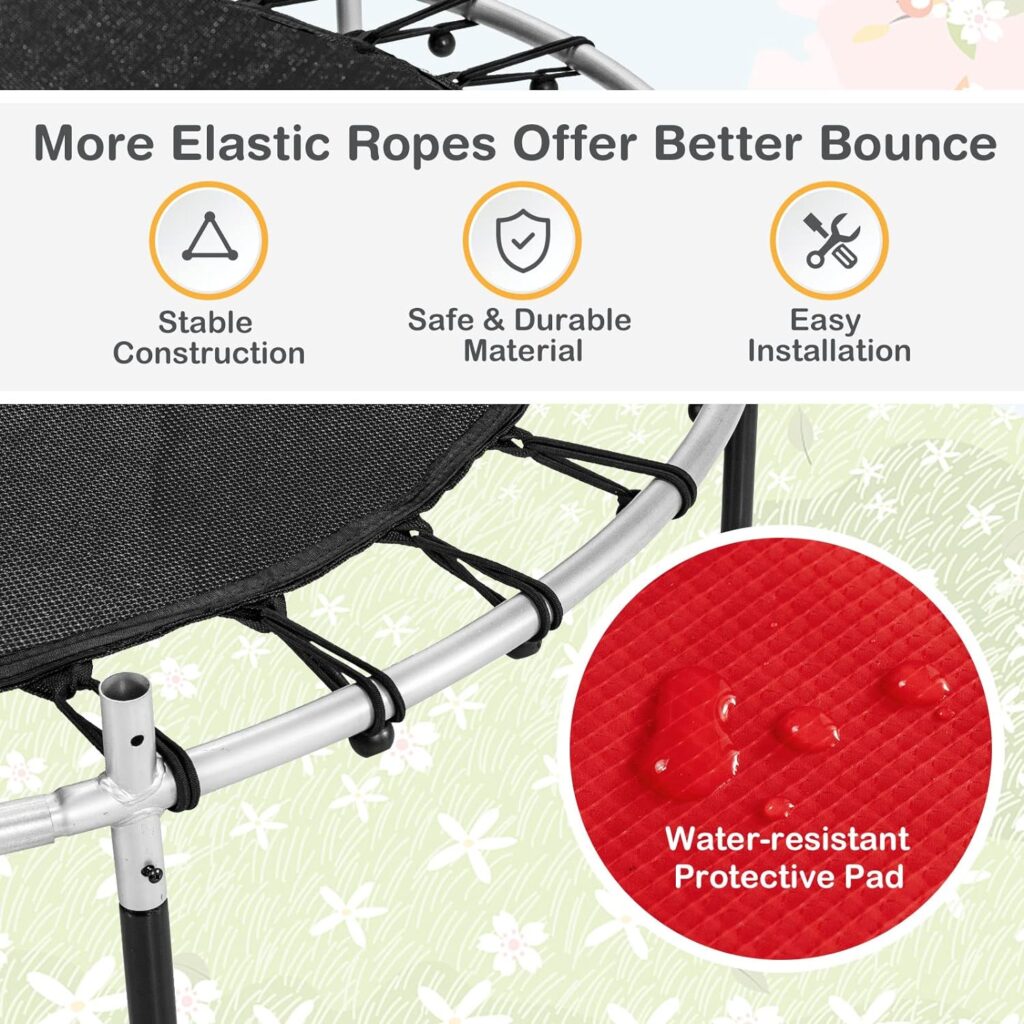Trampolines, a staple of joy and fitness, cater to all ages, inspiring kids and adults alike to leap out of their indoor routines into a world of exhilarating, healthy exercise. Trampolines aren’t just one-size-fits-all; they’re as varied as the people who bounce on them.
From expansive models that invite a group experience to compact units designed for solitary indoor use, there’s a trampoline tailored for every need, every space. Understanding the different types is key to selecting the perfect one for you and your family.
Let’s jump into the different types of trampoline and explore the variety that awaits.

Table of Contents
Key Takeaways
- Trampolines offer diverse types for exercise, fun, and serious sport.
- Understanding specific types helps in making the right choice.
- Safety, size, and design are critical factors in selection.
Round Trampolines

Round trampolines, the quintessential backyard fixture, are known for their universal appeal. They are designed to direct jumpers back to the center, minimizing accidents. The circular shape provides a uniform bounce, making them a family favorite. These trampolines fit perfectly in most outdoor spaces and are available in various sizes to accommodate different age groups and skill levels.
Rectangular Trampolines

Rectangular trampolines are used in the Olympic Games and all other professional Trampoline competitions sanctioned by the Federation of International Gymnastics. They are the second most popular type of trampoline used in backyards, after round-shaped trampolines. They are less forgiving than the round shape as you are less likely to be pulled back to the middle. However, they are generally bouncier as there is less distance between the center of the trampoline and the edges.
Rectangular trampolines are better for gymnastics-type skills like cartwheels and trampolines.
Bungee Trampolines

Bungee cord trampolines are a common alternative to springs. The cords provide a unique, softer bounce. This design reduces stress on the body, making it a safer option for children and adults alike. It also eliminates the chance of fingers or toes being trapped inside the springs as they shrink back to size.
Bungee trampolines are often used in smaller fitness trampolines or those aimed at younger children.
Water Trampolines

Water trampolines add a splash to the trampolining experience. Part inflatable air mat and part bungee trampoline, they ensure maximum fun! Designed for use on water bodies like lakes and pools, they combine the fun of bouncing with the joy of water play. These floating trampolines are perfect for summer days, offering a cool way to exercise and have fun under the sun.
Octagonal Trampolines
Octagonal trampolines, differing from the conventional round shape, offer more jumping space and a different bounce dynamic. Their corners provide a varied rebound effect, appealing to those looking for a slightly different trampolining experience. These trampolines are also known for their robust construction and durability.
Square Trampolines
Square trampolines offer the best of both worlds: the space efficiency of a rectangular trampoline and the safety features of a round one. Their unique shape allows for a larger jumping area, making them suitable for gymnastics and athletic training, as well as recreational use.
Mini-Trampolines
Mini-trampolines, also known as rebounders, are the go-to option for fitness enthusiasts. Compact and portable, they fit easily in homes and apartments, ideal for indoor exercise routines. These trampolines are perfect for aerobic workouts, helping in cardiovascular fitness while being gentle on the joints.
Oval Trampolines
Oval trampolines offer a larger jumping area than round ones, making them suitable for families with multiple children or for those who prefer more space to perform trampoline exercises. Their elongated shape allows for more room to move, providing a different bouncing experience.
Recreational Trampolines
Recreational trampolines are the common choice for backyard fun. These trampolines come in various shapes and sizes, catering to different preferences and budgets. They are designed for casual use, offering a great way to enjoy outdoor activities and encourage physical fitness among all family members.
Trampolines with Enclosures
Trampolines with enclosures are a step up in safety, featuring a net around the perimeter to catch any accidental bounces towards the edge. These are particularly popular among families with children, as they significantly reduce the risk of falls. The enclosure nets are usually made of durable, weather-resistant materials, ensuring a safe and long-lasting bouncing environment. They are ideal for both recreational and moderate athletic use, providing peace of mind for parents and fun for kids. Enclosures can be fitted to all shapes and sizes of trampolines.
Inflatable Trampolines
Inflatable trampolines are a portable and convenient option, perfect for temporary setups in backyards, parks, or even indoors. They are easy to set up and take down, requiring only an air pump. These trampolines are typically smaller and softer, making them suitable for younger children. Their inflatable nature also makes them a safer option, reducing the risk of injury from hard surfaces.
In-Ground Trampolines
Exposed in-ground trampolines offer a sleek, low-profile look, blending seamlessly with the landscape. They are installed at ground level, reducing the risk of high falls. This type of trampoline is particularly appealing for those looking for a more aesthetic and permanent solution in their backyard. While installation can be more complex (a large, water-tight hole needs to be dug), the safety benefits make them a desirable choice for many homeowners. They are also more hidden from view as they are sunk down into the ground and safety enclosures are not usually used.
Conclusion
There are many types of trampoline, each with its own unique benefits. For a comprehensive guide on selecting the right outdoor trampoline, explore this article, which provides detailed insights into making an informed decision.
Trampolines provide not only a source of fun but also a way to enhance physical fitness. From the ubiquitous round trampolines to specialized fitness models, there’s a type to suit every need and preference. Whether you’re considering an in-ground or above-ground installation, understanding the various types of trampoline helps in making the best choice for your space and requirements. For more information on in-ground versus above-ground trampolines, visit this in-depth article.
FAQs
What Should I Consider When Buying a Trampoline?
When purchasing a trampoline, consider the size, safety features, type, and intended use. Also, think about the space where it will be placed and who will be using it. Follow our in-depth guide here on How To Choose a Trampoline.
How Do I Maintain My Trampoline?
Regular maintenance includes checking for tears, ensuring springs are intact, and cleaning the surface. It’s also important to secure it properly to avoid damage from strong winds and winterize it in colder months.
Are Trampolines Safe for Young Children?
Yes, trampolines are safe for young children, especially models designed for them, like mini or enclosed trampolines. Always supervise children and ensure they follow safety guidelines.
